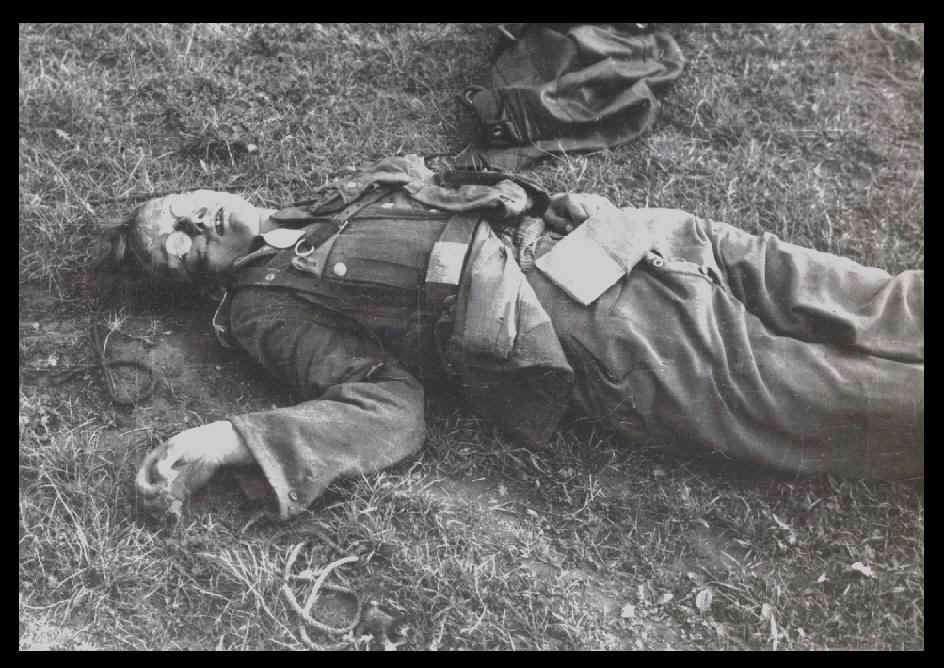
Image du Jours -- World War II
About this Ruin of War -- WWII #21 of 23.

(Image from Stockum-Cashion Collection)
GOTT MIT UNS
I have walked the paths through curved rows of white grave markers at the Cambridge American Cemetery, Cambridgeshire, England. Buried there are 3,835 American airman and seamen.
And there, I have walked beside the long reflecting pool adjacent the equally long Wall of the Missing, on which are etched the names of 5,125 Americans. Many were airmen, but most were seamen lost in the cold waters of the North Atlantic.
I have sat in the prayer chapel at the end of the pool and pondered futilely the same questions that many have -- every father, every mother, wife, sweetheart, and all the kin who were missing a loved one: 'Was it all worth it?'
Any other time, at any other place, I could have recited some John-Wayne-patriotic answer. But then, and there, such an answer seemed shallow. I left the chapel feeling empty.
I found my answer two weeks later but it wasn't in a cemetery for the war dead. It was in a river-side meadow in England, watching young, playing children -- their soft, blonde silky hair was rimmed with the gilded light of a setting sun -- a playground bordered by the clear, clean waters of the Avon with weeping willows hanging over each bank.
Wellington had said, "Nothing except a battle lost can be half so melancholy as a battle won."
The dead have no interests in the outcome.
They did not win.
They did not lose.
They just died.
We can look at this young German, properly Nordic, properly blonde, and we can look at his face but not see his eyes. We cannot know him. Perhaps a lot of people did. His death might have been mourned by many, and any of them could have recognized him in the picture -- but we cannot.
The sky is now slightly overcast, reflecting a foggy light from glasses and belt buckle.
He represents many things to us.
I wonder how he died.
When?
It must have been recently.
Yesterday?
Did he die because a miscellaneous round was fired from an unseen American tank that was just firing in the general direction of a soon-to-be deserted air field?
There is no wound that I can see, yet he appears to have broken limbs. (But broken limbs are survivable.)
How long did he live after...after what?
He lived long enough for his heart to fill his lungs and throat with enough blood to wet his mouth and leave his nose -- but not much longer.
There is no evidence of flash burns. If it was concussion rupturing lungs, his glasses stayed on. Perhaps there was a back wound.
The weather had been rather chilly.
He had been in service a while or he was issued a used uniform. This was done a lot late in the war. His sleeve cuffs show wear and there is wear on the inside of his jacket.
His uniform is in disarray because someone has gone through his pockets.
And I think someone placed a tarp over him. They could cover him but not bury him. That was all the respect they had time for.
And someone else had removed the tarp.
His buckle has an eagle holding a swastika in its talons. At the lower rim is a half-round wreath, and in an arc over the top of the eagle is GOTT MIT UNS.
I know this because I have one of these buckles beside me now as I write. My uncle in the 36th Division removed it from a dead German soldier somewhere in Italy. Part of the leather belt is still on my buckle. A stamp in the leather reads "Minden, 1940."
And what of our young man?
What is the packet by his left hand?
Perhaps his enlistment and ID papers, they were that size. Or it could have held the tobacco he enjoyed in his straight-stemmed, briar pipe, which is still within reach of his right hand.
GOTT MIT UNS -- "God is with us" -- Lets hope He was for this young lad that spring day of 1945.
The young man hadn't known that the Russians were going to stop at the Elbe, just to the north.
But he would have known the Americans were just to the south and west.
Surrender?
Leave?
And he would have known that soon the Russians would be in Berlin.
And the war would be over.
And he could go home.
Ken Cashion